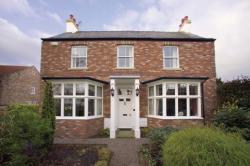Eurobrick Systems - A guide to brick slip cladding for self builders
 Despite many different cladding finishes being available, there is an abiding love for real brick. Brick adds character to a building, with a tactile finish that is both attractive and very durable.
Despite many different cladding finishes being available, there is an abiding love for real brick. Brick adds character to a building, with a tactile finish that is both attractive and very durable.
In modern construction, a brick wall is little more than a rain screen for a house, simply protecting the structural inner skin from the weather. Brick slip cladding performs the same function as a traditional masonry wall but also has other benefits which can be very useful. Eurobrick is the UK’s leading brick slip cladding specialist, so if you are considering a brick slip finish for your self-build project we are here to help.
Brick slip cladding is not a new phenomenon, we were the first to introduce it to the UK in 1990. You probably see buildings finished with brick slips all the time without even realising it, and that is the point, brick slips are largely indistinguishable from traditional masonry. However, brick slip cladding systems are light weight in comparison and can incorporate layers of insulation while remaining relatively thin in profile.
There are a number of different cladding systems available on the market, but they are not all the same. Each system varies in terms of component parts and assembly method. At Eurobrick, our advice to anyone considering brick cladding is to think about your objectives and which benefits of brick slip cladding best serves these. Which system you choose depends upon the specific requirements of your project; does it need to be lightweight, are you or your contractors installing the system, how much insulation do you need, if any? Speak to the suppliers’ technical staff, as they should be happy to answer all your queries. You should also ensure that your chosen system is properly developed and tested and that it has the required fire performance for your application.
As a self-builder, you can choose from a variety of structural construction methods, including steel and timber frame, Structural Insulated Panels (SIPs), Insulated Concrete Formwork (ICF) to name a few. These different structural elements can be finished with brick slip systems. Cladding systems are non-structural and do not require the foundations associated with traditional masonry being largely suspended directly from the structural fabric. The benefit of being low weight can simplify the design and cost of foundations under modern structures. Some systems can be assembled by semi-skilled labour with some even suitable for DIY installation. This reduction in the dependency on traditional trades to deliver traditional finishes can also lead to cost savings in a project.
If you are planning to extend your existing home, the technical constraints or desired aesthetics of some projects may require that a cladding system is used. For example, if you are adding an additional floor to an existing structure, a light weight system may be essential. Or maybe it is an extension that requires the original and new part to be over-clad to provide a contiguous finish.
For renovation projects, insulated brick cladding is an ideal product. Some brick cladding systems provide external wall insulation, which, as it is installed on the outside of the building, means that precious internal floor space is not reduced and disruption to the occupiers can be kept to a minimum.
In addition to the improvement in thermal performance, cladding can also solve common problems experienced in older properties, namely condensation, damp penetration and dilapidation of the exterior. Well designed and installed systems will weatherproof the original fabric of the building, keeping wind driven rain out, reducing condensation risk and rejuvenating the exterior with a new skin of brick.
With the enormous range of brick slips available, choosing the right brick can be a long process. Once again, clearly identifying the project objectives and constraints may quickly focus the search. It could be cost or the need for a particular brick type to match a local vernacular. Sustainability may be the primary objective and you want extruded brick slips (extruded brick slips use 60-70% less energy to manufacture than standard bricks). Perhaps you are looking for a brick slip with a characterful, aged appearance. Regardless of criteria, there most certainly will be a brick slip to match your requirements.
As one would expect, the cost of using a brick slip system will vary not only from system to system but will also depend upon the choice of brick, the amount and type of insulation required, the size of project, and who will install the system. Because every project is different, in order to obtain a meaningful estimate, we recommend that you speak directly to the cladding suppliers to discuss the particulars of your build. If you are able to provide an area or even plans of the project, the cladding company will be able to calculate an estimate which is specific to your build and choices. Ask for advice on any extras that may be required, as basic “headline” prices based on a square metre rate can be deceptive. This will give you a more accurate figure to work with your budgets.
Hopefully this has given you a brief insight into how brick slip cladding can provide an effective alternative to traditional construction. Not only can cladding help solve a range of technical challenges but, just like traditional brickwork, the end result is low maintenance, very durable and looks great.
We are always happy to answer any questions you may have about your project. Please give us a call on 0117 971 7117 or email info@eurobrick.co.uk